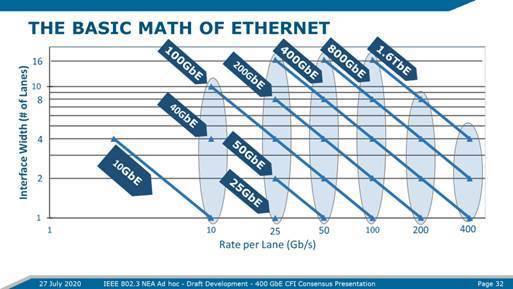Hello Cedric,
This is very helpful insight. If you could present even some simple diagrams educating us on the trade-offs, that would be awesome.
Unfortunately 200 Gb/s per lane technology, electrical or optical, is not ready for standardization so how best to move forward is a complicated question.
I am always appreciative when Google shares their fundamental insights with industry to help us move in the right direction. The analysis that Google presented several years ago, when industry was debating the next step after 100GbE, showing
that 200GbE is the right answer has proven to be prescient. Most cloud operators have now realized this.
Chris
From: Cedric Lam (林
峯) <000011675c2a7243-dmarc-request@xxxxxxxxxxxxxxxxx>
Sent: Sunday, August 02, 2020 12:18 PM
To: STDS-802-3-NGECDC@xxxxxxxxxxxxxxxxx
Subject: Re: [802.3_NGECDC] Input Requested for Beyond 400 GbE CFI
Chris:
I cannot make the prediction you asked. What I can tell you is that machine learning (at least the one from Google) uses a torus architecture to construct the pod. This is public information. So the speed required per link is high (as
there are not as high radix as the connections used to form Clos for DC fabric. WE should probably also ask the HPC guys. For those applications, super low latency is also very important. But the physical layer will be the same for short reach interconnects
and both applications can cross leverage each other.
--
Cedric F. Lam
Cell: +1 (949) 351-2766
On Sat, Aug 1, 2020 at 3:49 AM John D'Ambrosia <jdambrosia@xxxxxxxxx> wrote:
Chris,
In the past the question you asked below has been used to justify the next speed, not the justification for the speed in question itself. So I am trying to understand your question. It would seem the question you want to ask would be related to 100G, not 200G.
Just trying to understand what you are getting at to see if additional data is needed.
Thanks
John
From: Chris Cole <chris.cole@xxxxxxxxxxx>
Sent: Saturday, August 1, 2020 1:20 AM
To: STDS-802-3-NGECDC@xxxxxxxxxxxxxxxxx
Subject: Re: [802.3_NGECDC] Input Requested for Beyond 400 GbE CFI
Hi Cedric
When do you think the 1st million optical transceivers with 200G I/O will ship? It can be any configuration; Nx200G, Nx400G, 800G, etc.
Chris
From: Cedric Lam (林 峯) <000011675c2a7243-dmarc-request@xxxxxxxxxxxxxxxxx>
Sent: Friday, July 31, 2020 9:35 AM
To: STDS-802-3-NGECDC@xxxxxxxxxxxxxxxxx
Subject: Re: [802.3_NGECDC] Input Requested for Beyond 400 GbE CFI
I can see 1x200G as something useful for server to TOR connections in the future and might be easy to add to the Ethernet family. I agree with you on the 2x200G. Also, bear in mind the limited distances that 200G lane can cover and the use cases. We see it mostly in the intra-DC applications.
On Fri, Jul 31, 2020 at 8:05 AM John D'Ambrosia <jdambrosia@xxxxxxxxx> wrote:
All,
I received a question after this week’s NEA meeting that I would like to get some feedback on from others.
The question was –
If 200 Gb/s per lane signaling were developed could efforts to define 200 GbE based on 1x200 Gb/s and 400 GbE based on 2x200 Gb/s be addressed.
I think it is actually a good question and important for me in developing the CFI Consensus deck and defining the SG chartering motion. As shown by the slide below - 200 Gb/s signaling is applicable to 200 and 400 GbE. 400 Gb/s serial signaling might also be applicable to 400 GbE.
My own personal opinion is that the whole 1x / 2x lanes would then need to be examined on a PHY basis – as we have seen some instances where 2x lanes don’t see market adoption.
This also raises the question as to whether the study group would define more than one PAR. Based on the above text – I think there is an opportunity for that or another project that spins out efforts based on consideration of schedule.
So I would appreciate some feedback from individuals as it impacts the consensus deck
Thanks in advance.
John
To unsubscribe from the STDS-802-3-NGECDC list, click the following link: https://listserv.ieee.org/cgi-bin/wa?SUBED1=STDS-802-3-NGECDC&A=1
To unsubscribe from the STDS-802-3-NGECDC list, click the following link: https://listserv.ieee.org/cgi-bin/wa?SUBED1=STDS-802-3-NGECDC&A=1
To unsubscribe from the STDS-802-3-NGECDC list, click the following link:
https://listserv.ieee.org/cgi-bin/wa?SUBED1=STDS-802-3-NGECDC&A=1
To unsubscribe from the STDS-802-3-NGECDC list, click the following link: https://listserv.ieee.org/cgi-bin/wa?SUBED1=STDS-802-3-NGECDC&A=1
